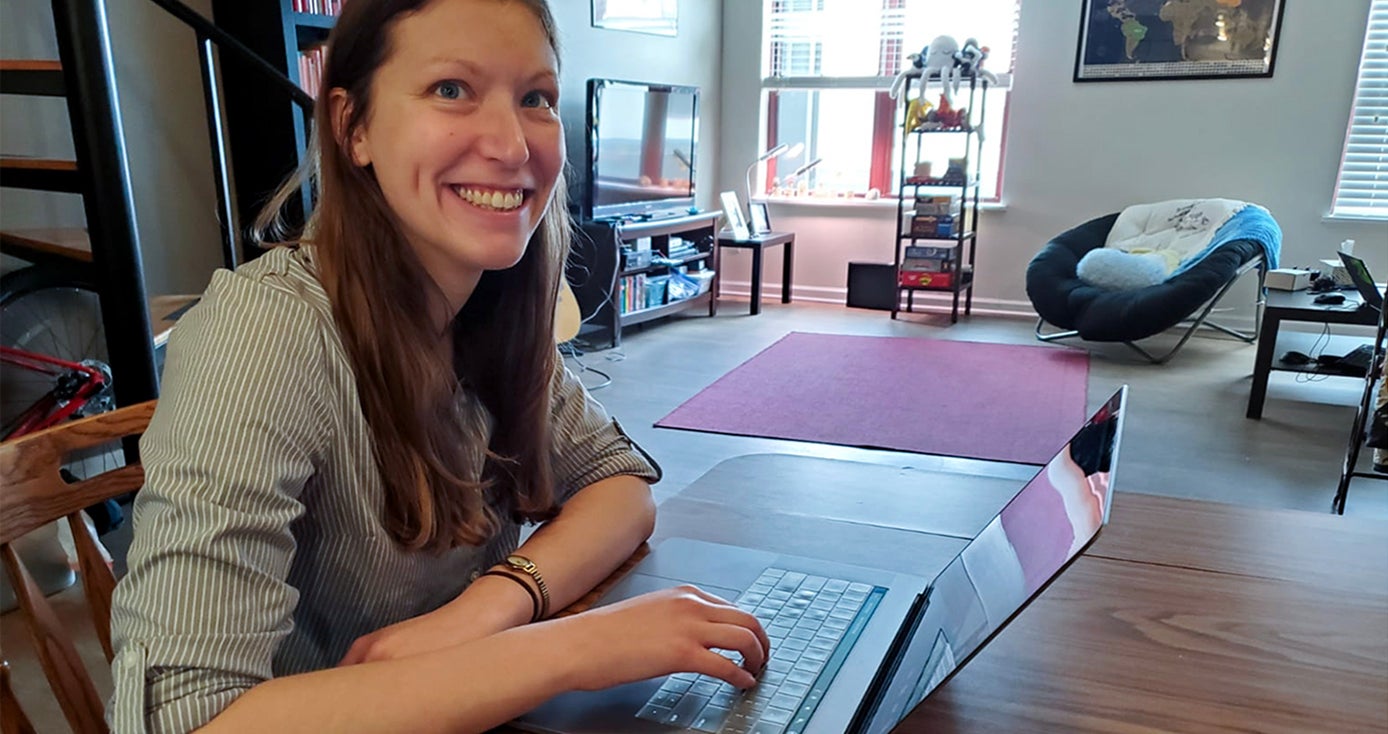
Subscribe to Pittwire Today
Get the most interesting and important stories from the University of Pittsburgh.Proactive Work of Computer Scientists Prepared Infrastructure to Withstand Pandemic
As a computer scientist, Amy Babay has dedicated her career to maintaining the technology infrastructure we rely on every day. And during the COVID-19 crisis, many are depending on technology even more to try and keep up with their daily routines. Video calls are up 212% and VPN traffic has increased 40%, according to cable provider Comcast.
“In some ways, the crisis has made some of the research and work I do more personal in terms of ‘Wow, we are really depending on our networks and internet services to work right now,’ and it does work,” said Babay assistant professor of the University of Pittsburgh’s School of Computing and Information (SCI) “For the most part, things haven’t stopped. A lot of technology is making this possible.”
Paul Cohen, dean of SCI, agrees. “Would social distancing succeed without the internet? Thanks to this infrastructure and the brilliant people who develop it, we are able to flatten the curve and continue to function pretty well as a university and as a society. It truly is life-saving technology.”
Technology’s crucial role in keeping our society functional amid lockdowns is highlighted in a new list by the World Economic Forum’s 10 trends that can help build a resilient society. The top five are: Online shopping and robot deliveries, digital and contactless payments, remote work, distance learning and telehealth.
Babay said she’s been impressed with “the degree to which life has gone on,” but recognizes that there have been challenges along the way.
“Part of the challenge has been adapting to a new way of doing things,” she said. “Especially people in parts of the country without strong internet access, like rural areas, it could be especially frustrating to try and participate in an online class or meeting.”
Are we putting the system under pressure?
More than half (53%) of U.S. adults say the internet has been essential for them during the pandemic and another 34% describe it as “important, but not essential,” according to a new Pew Research Center survey. Despite the increase in demand, Babay said that we aren’t necessarily in a panic phase of testing the limits of the internet or most major online services because a lot of computer science research has been focused on preparing for a time like this.
“For the most part, I think things are pretty stable. A lot of my research is on fault tolerance and scalability. Those are key principles of how the systems are designed,” said Babay.
Fault tolerance, or the ability to keep working even if parts of the infrastructure fail, allows the internet to reroute if physical links don’t work. And scalability, she said, gives the infrastructure the ability to cope with increased demand.
Part of the challenge has been adapting to a new way of doing things.
Amy Babay
Through SCI, scientists, engineers, policy experts, clinical faculty and students from across the University collaborate to solve some of the world’s most complex problems. Babay’s current projects include creating scalable techniques for high-quality remote interaction, making critical infrastructure like the power grid resilient to cyber attacks and improving the long-term reliability of citizen science sensor networks to support environmental monitoring and modeling.
She explained that the internet isn’t designed for things to be perfect all the time; it’s ready to respond and react when things go wrong.
“Protocols that transmit our data take into account that congestion and failures will happen. And the infrastructure has been built so that we don’t come to a total halt when things go wrong,” she said.
Advances in video quality
Before coming to Pitt in fall 2019, Babay worked at a company that operates global overlay networks and transports live video for the TV and media industries, including interviews and sports games.
“My research at Pitt is on taking that model and moving to the next level of interactivity by reducing the delay while keeping quality high, making for a more real-life experience,” she said. That work aims to support uses even more demanding than video, like manipulating robots from across the country.
“We’re looking into questions like ‘Can we actually get quality of service you need from any point in the world to another?’ One goal would be to apply this to remote surgeries, where delay requirements are a lot tighter than for video,” she said.
Today, during the pandemic, she said the increase in video conferencing does put a stress on the network, but not to the point where we’ll notice. And advances by computer scientists have made this a more real-life experience, she said.
“If available bandwidth isn’t that high, or there’s a lot of congestion, we can now automatically detect that and react to it. Maybe your picture is choppier, but it still feels real-time and interactive,” said Babay. “That’s the most important thing needed for us to feel like we’re in the same room.”
Lessons learned
Babay said that amid the pandemic, computer scientists like herself should remember that all services should be treated as critical from the start.
“The fact that we have internet services that we do today is what’s making this connectivity possible,” said Babay. “A lot of people were worried about how this will work in terms of increased levels of demand. And thankfully, for the most part, this has not put too much pressure on the infrastructure, but there are definitely places where that’s not true, and there are definitely problem spots.”
She said that’s especially true for “niche sites” that don’t expect to get a lot of users.
“We’ve seen services that don’t anticipate to get a lot of users suddenly get a lot of demand and visibility that they weren’t prepared for—like the small board game website I use, or the yoga streaming website that went down in the middle of a session,” she said.
On a personal note, Babay learned a lesson of her own. During the first week of remote working, she found that her router wasn’t giving her a good connection to operate from home.
“I spent the first week of working from home sitting on the floor in my bedroom connected to my modem with an ethernet cord. So, as a silver lining, it prompted me to get a new router,” she said with a laugh.
Collaborating across campus
Through SCI, scientists, engineers, policy experts, clinical faculty and students from across the University collaborate to solve some of the world’s most complex problems. During the pandemic, Cohen teamed up with Tomasz Loboda, research scientist with the Learning Research and Development Center, to work on simulations to test the effectiveness of interventions such as social distancing and shelter-in-place. Cohen and Loboda intend to use their open source PRAM system to search for good interventions and hand them off for more detailed evaluation by sophisticated epidemiological simulators such as FRED, developed by Pitt’s Graduate School of Public Health.
In addition, SCI faculty members Yu-ru Lin and Adriana Kovashka are working with Wen-Ting Chung, instructor in the School of Education, on a RAPID grant from the National Science Foundation to model and counteract the false information about COVID-19 and how to deal with it. Using machine learning and data mining, they will create an AI system that identifies which false information is influential, who is most affected by it and how to identify this information automatically in social media. Their debunking system will rely heavily on visual rhetoric, which is effective for low-literacy populations.



